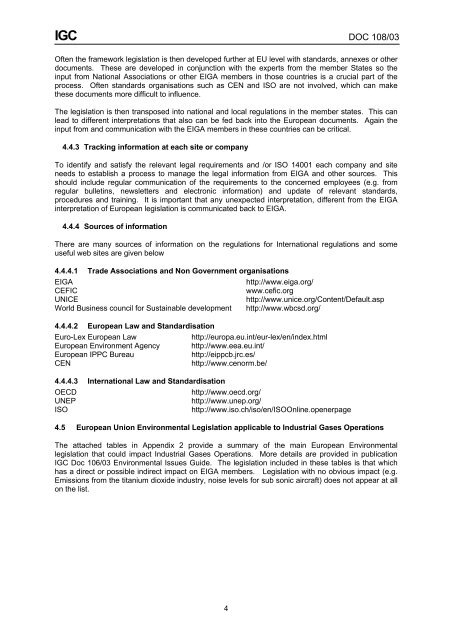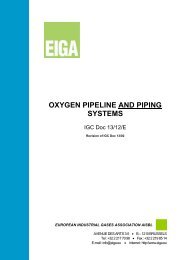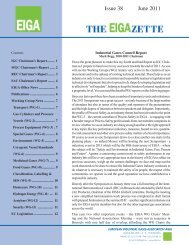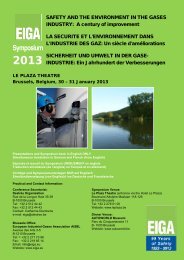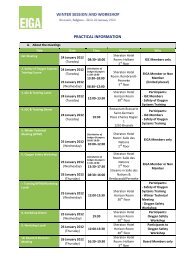environmental legislation applicable to industrial gases ... - eiga
environmental legislation applicable to industrial gases ... - eiga
environmental legislation applicable to industrial gases ... - eiga
You also want an ePaper? Increase the reach of your titles
YUMPU automatically turns print PDFs into web optimized ePapers that Google loves.
IGC DOC 108/03<br />
Often the framework <strong>legislation</strong> is then developed further at EU level with standards, annexes or other<br />
documents. These are developed in conjunction with the experts from the member States so the<br />
input from National Associations or other EIGA members in those countries is a crucial part of the<br />
process. Often standards organisations such as CEN and ISO are not involved, which can make<br />
these documents more difficult <strong>to</strong> influence.<br />
The <strong>legislation</strong> is then transposed in<strong>to</strong> national and local regulations in the member states. This can<br />
lead <strong>to</strong> different interpretations that also can be fed back in<strong>to</strong> the European documents. Again the<br />
input from and communication with the EIGA members in these countries can be critical.<br />
4.4.3 Tracking information at each site or company<br />
To identify and satisfy the relevant legal requirements and /or ISO 14001 each company and site<br />
needs <strong>to</strong> establish a process <strong>to</strong> manage the legal information from EIGA and other sources. This<br />
should include regular communication of the requirements <strong>to</strong> the concerned employees (e.g. from<br />
regular bulletins, newsletters and electronic information) and update of relevant standards,<br />
procedures and training. It is important that any unexpected interpretation, different from the EIGA<br />
interpretation of European <strong>legislation</strong> is communicated back <strong>to</strong> EIGA.<br />
4.4.4 Sources of information<br />
There are many sources of information on the regulations for International regulations and some<br />
useful web sites are given below<br />
4.4.4.1 Trade Associations and Non Government organisations<br />
EIGA http://www.<strong>eiga</strong>.org/<br />
CEFIC www.cefic.org<br />
UNICE http://www.unice.org/Content/Default.asp<br />
World Business council for Sustainable development http://www.wbcsd.org/<br />
4.4.4.2 European Law and Standardisation<br />
Euro-Lex European Law http://europa.eu.int/eur-lex/en/index.html<br />
European Environment Agency http://www.eea.eu.int/<br />
European IPPC Bureau http://eippcb.jrc.es/<br />
CEN http://www.cenorm.be/<br />
4.4.4.3 International Law and Standardisation<br />
OECD http://www.oecd.org/<br />
UNEP http://www.unep.org/<br />
ISO http://www.iso.ch/iso/en/ISOOnline.openerpage<br />
4.5 European Union Environmental Legislation <strong>applicable</strong> <strong>to</strong> Industrial Gases Operations<br />
The attached tables in Appendix 2 provide a summary of the main European Environmental<br />
<strong>legislation</strong> that could impact Industrial Gases Operations. More details are provided in publication<br />
IGC Doc 106/03 Environmental Issues Guide. The <strong>legislation</strong> included in these tables is that which<br />
has a direct or possible indirect impact on EIGA members. Legislation with no obvious impact (e.g.<br />
Emissions from the titanium dioxide industry, noise levels for sub sonic aircraft) does not appear at all<br />
on the list.<br />
4


